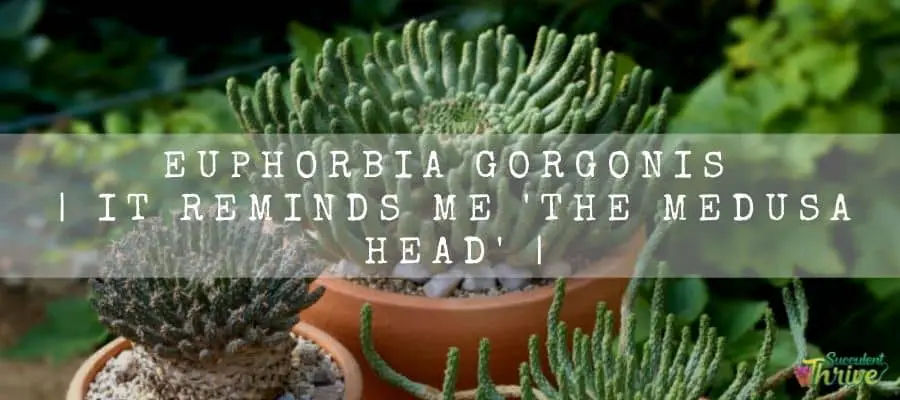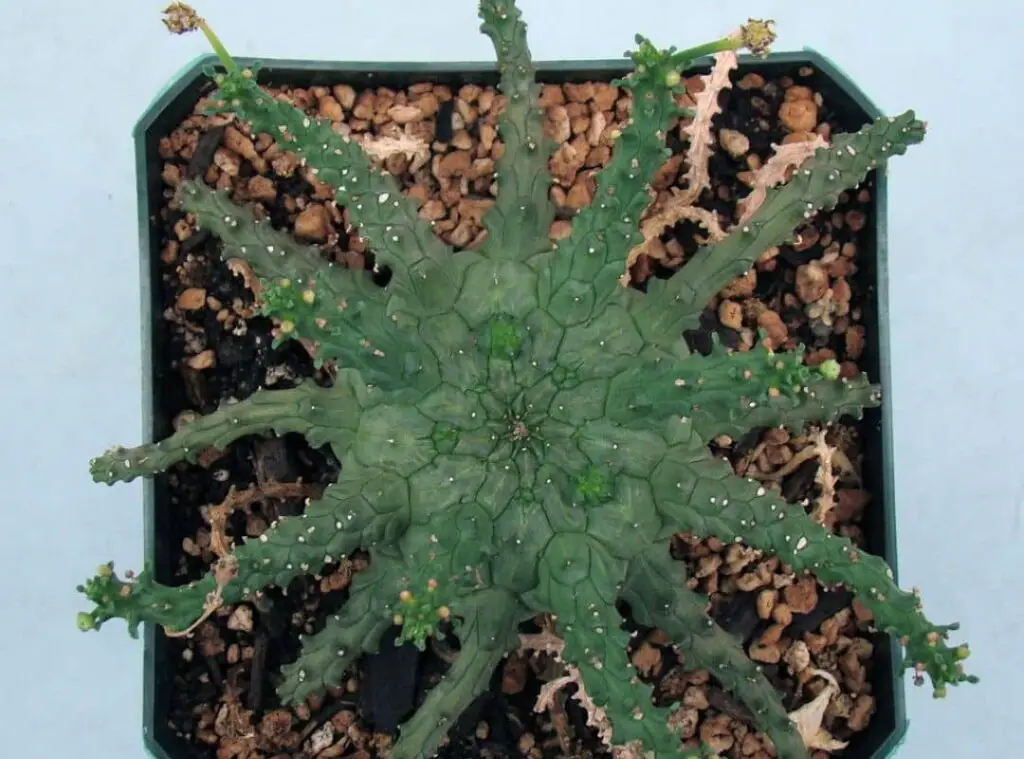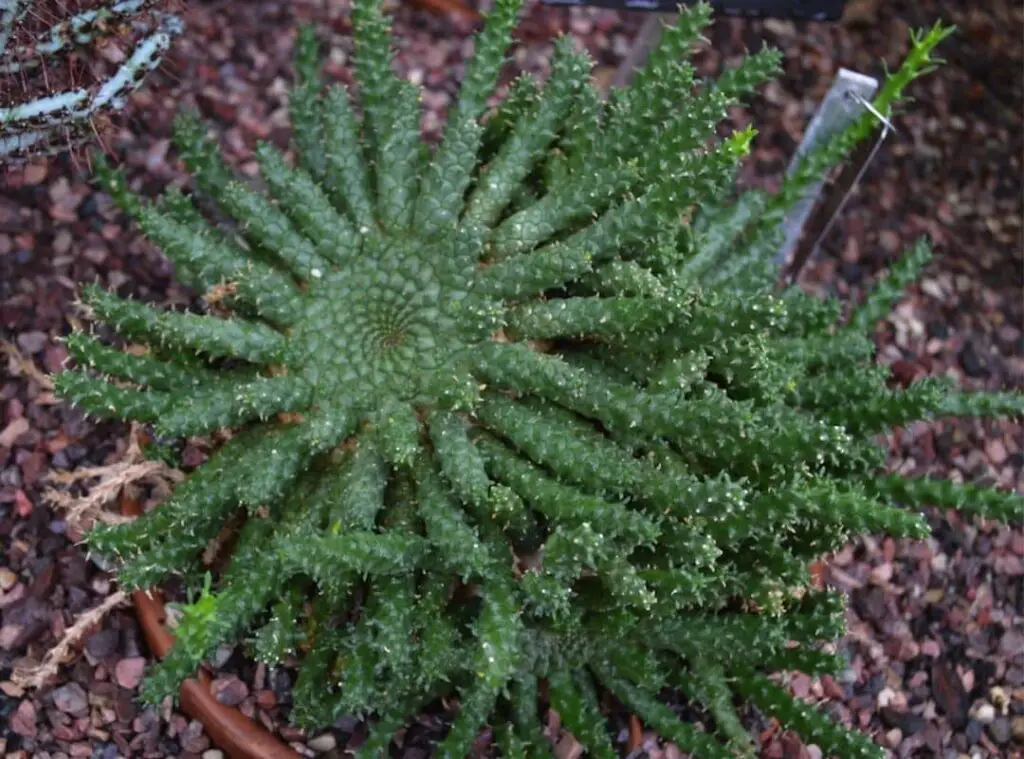Euphorbia gorgonis is a unique caudiciform succulent. You can also call these plants caudex succulents as their roots form a bulb which merges with the central stem.
Euphorbia gorgonis are originally from South Africa. You can commonly find them in flat to hilly terrains. These grow in the desert areas. Alwin Berger had named these plants in 1910.
They require easy maintenance from you. They are hardy and versatile plants, and it would be worthwhile growing them in your indoor garden collection. If you are curious to learn about these amazing plants , you will find this article very useful for you.

How do I identify Euphorbia gorgonis?
As aforesaid their roots form a bulb which merges with the central stem. You could see an elongated cylindrical stem which consists of numerous protuberances. Further they will carry scars from the fallen leaves in the root area.
They have got the name called gorgonis due to the apical stems they have . They have a closer resemblance to the snake hair of the mythological Medusa. Moreover, the central part of the plants carries an influence as well.
As aforesaid , Euphorbia gorgonis stems would be globes or obconic and would be about 5-10 cm in width. They will grow up almost buried in the ground.
Euphorbia gorgonis leaves can be spotted only on the young growth and they will be deciduous. They will be 1-2mm in size. Besides they will be lanceolate, elliptic , acute, and glabrous.
Euphorbia gorgonis peduncles are solitary and are 4-10 mm long. These plants produce yellow flowers and you could use that feature to identify these plants.
Besides all these features, Euphorbia gorgonis has fruits which are sessile or subsessile. They will be about 4mm in diameter and subglobose. Moreover, they will consist of hairs when they are young.
The fruit consists of seeds as well. The seeds are about 2.5 mm in length. Further they will be blackish gray in color. They have a closer resemblance to Euphorbia woodii.
Size of the plant
Euphorbia gorgonis would be 2-3 cm in height when they grow to the fullest.
Growth rate
Euphorbia gorgonis are slow growing plants. Further, when they establish, they will live for a longer period.
One look care guide
| Botanical Name | Euphorbia gorgonis |
| Common Name | Melkbol |
| Plant Type | Succulent , cactus |
| Mature Size | 2-3 cm in height |
| Sun Exposure | Full sunlight to partial shade |
| Soil Type | Well draining / gritty |
| Soil pH | Soil pH requirements: 6.1 to 6.5 (mildly acidic). |
| Flower Color | Yellow |
| Hardiness Zones | USDA Zone 9b: to -3.8 °C (25 °F) |
| Native Area | South Africa |
| Toxicity | Toxic |
| Average price | 8 USD |
How do you take care of Euphorbia gorgonis?
Light Requirement
Euphorbia gorgonis can thrive in moderate shade. Hence if you bring them outdoors to expose for full sunlight, you should do it while acclimating them to full sunlight.
Consider that if you expose them under scorching sunlight at once, then it would scorch the plants and make them traumatized.
They can tolerate full sunlight also given that you do not expose them under direct sunlight particularly during the intense afternoon sunlight.
Literally morning sunlight and partial shade in the afternoon would be healthy for these plants’ firm growth.
Temperature and humidity
Warmer temperatures would go well with the Euphorbia gorgonis plants. Avoid leaving them exposed for colder weather as it could be harmful for the plants and make the plants’ health deteriorate.
Is it cold hardy?

USDA hardiness Zone
The conditions of USDA Zone 9b: to -3.8 °C (25 °F) would be ideal for the healthy growth of the Euphorbia gorgonis plants.
Watering Requirement
You need to water the Euphorbia gorgonis plants regularly during their active growing season. Having said that, do not ever let any waterlogged condition remain at the roots.
During winter, keep them dry unless it would make the plants more attractive towards root rot. They are drought tolerant plants which literally means they can thrive well despite you neglecting watering them once or twice.
What you should keep in mind is not to provide them water in abundance as it would create so many bad repercussions on the plants.
It is crucial that you water them well as it will have a greater impact on the Euphorbia gorgonis plants’ wellbeing.
Soil Requirement Type / pH
Euphorbia gorgonis prefer to thrive in a gritty soil mix. The purpose of growing them in a gritty soil mix is to provide good drainage for the plants.
Once you grow them in a well-draining soil mix, it will ensure that there will be no excess moisture remaining in the plants. If you grow them in a regular soil mix, it will only create diseases such as root rot.
Additionally, the potting medium should have a good aeration as well. You may go ahead with a substrate which has non organic material. For example, the right potting medium should consist of clay, pumice lava grit along with a little peat.
Pot size Potting and Repotting
Ensure that the pot you are selecting consists of a draining hole so that the excess water can move through.
Additionally , you can go ahead with a pot material such as clay or terracotta as they would be quite healthy for the plant’s growth.
You can consider doing repotting once every two years. The reason for that is because they are a slow growing set of plants and they can thrive in the same pot for some time. Having said that, if the plants are suffering from any disease, you need to repot them.
Where to Plant
Ensure that you select a place where these plants can obtain sufficient sunlight as it is one of the prime requirements of the plants. Besides, chose a well-draining soil mix as the growing medium as explained in the above.
Fertilizer and time of year
Euphorbia gorgonis would prefer to have a fertilizer when they are actively growing during summer.
You can go ahead with a cactus or a succulent fertilizer which has a high component of potassium as well as micronutrients. Further ensure what you are using is a slow release.
Flower
Euphorbia gorgonis produce yellow flowers which are small.
Dormancy
Euphorbia gorgonis could go dormant in fall as well as in winter. When they are dormant, skip feeding them as well as watering them.

Toxicity
Euphorbia plants are toxic in general and Euphorbia gorgonis are no different to them.
Common bugs and illnesses
Euphorbia gorgonis are prone to root rot.
If you had supplied them water in excess and grew them in a poorly aerated soil mix, it will make the plants vulnerable to root rot.
Root rot could be so dangerous as chances are that you may even lose the plants if it spreads on a severe level.
Additionally, you need to protect the plants from regular pests such as from mealybugs, aphids etc.
the lapses in the care treatments would make them more vulnerable for these pest’s attacks. Hence it is critical that you practice the right growing care tips for them.
Special Care tips
Euphorbia gorgonis generate milky sap once you cut them. Hence ensure that you are protecting yourself before you start interacting with the plants.
Milky sap is called latex and it could be poisonous and cause irritations in the skin. Ensure that you do not let the latex get in contact with your eyes or mouth as it could be harmful.
Besides, I recommend you conduct regular check ups on the plants so that you could see whether your plants are growing healthily. Furthermore, it will enable you to identify if there are any early signs of any upcoming issue
Benefits
Euphorbia gorgonis are useful as ornamental plants. In fact, many succulent enthusiasts tend to grow them as ornamental plants. Additionally, they would be great picks for outdoor gardening as well.
How to propagate Euphorbia gorgonis
You can use the seeds propagation methods and the cutting propagation methods to propagate them.
If I elaborate further on the cuttings, you need to obtain the cuttings from the plants first. However, when you do, ensure that you are protecting yourself from the sap they release when you cut.
Next allow them to wither. That will allow the wounds to heal and develop callousness. Next grow them in a well-draining soil mix.
Ensure that you are placing the cuttings upwards so that the roots can grow downwards vigorously.
Conclusion
To wind up, Euphorbia gorgonis are versatile, attractive plants which anybody would fall in love with.
If you ensure that you adhere to the aforesaid guidelines, it will be quite easy to maintain them and that will help them to grow to their fullest potential.
Read Next : Portland Spurge (Euphorbia Portlandica) | A Plant You Should Know! | Euphorbia Lactea Variegata Care | A Few Essential Steps | Euphorbia Problems | 15 Major Problems They Encounter |
